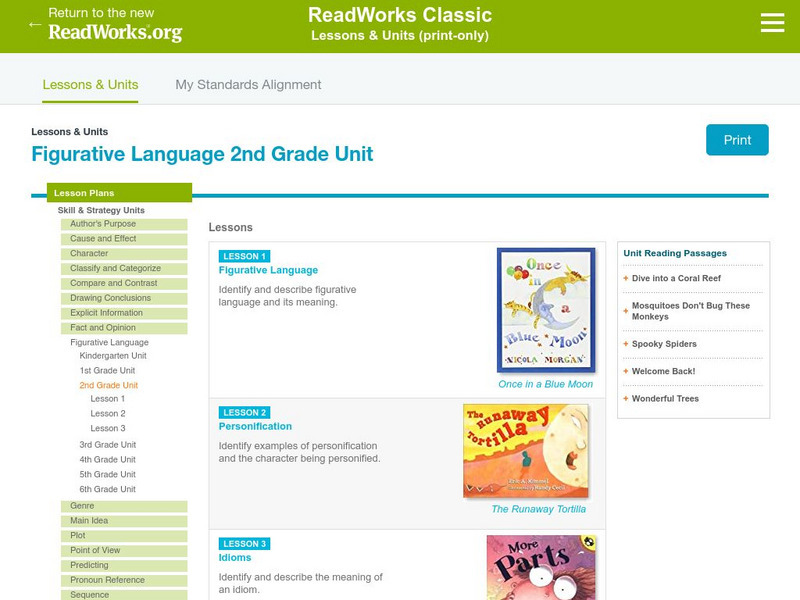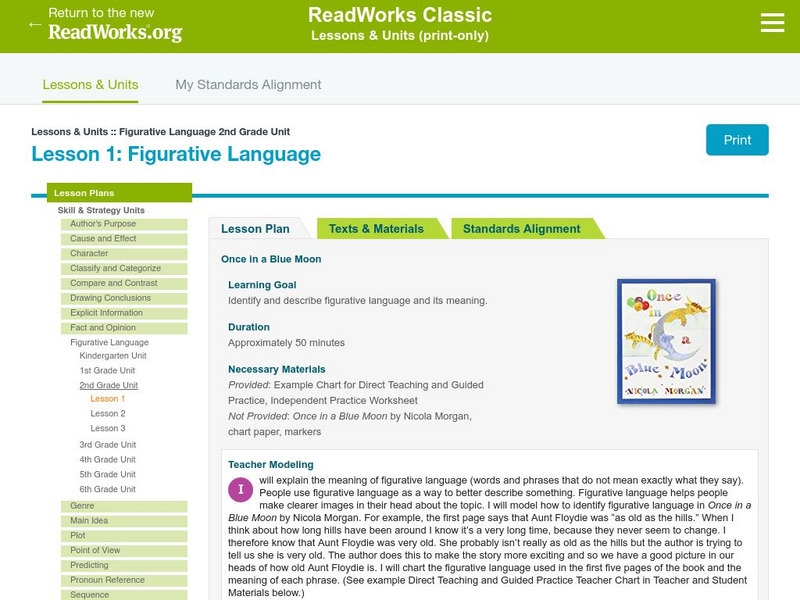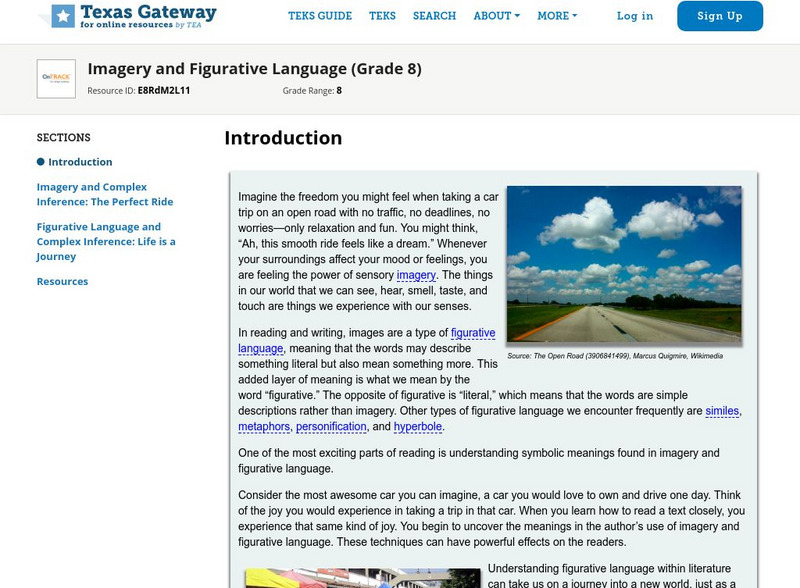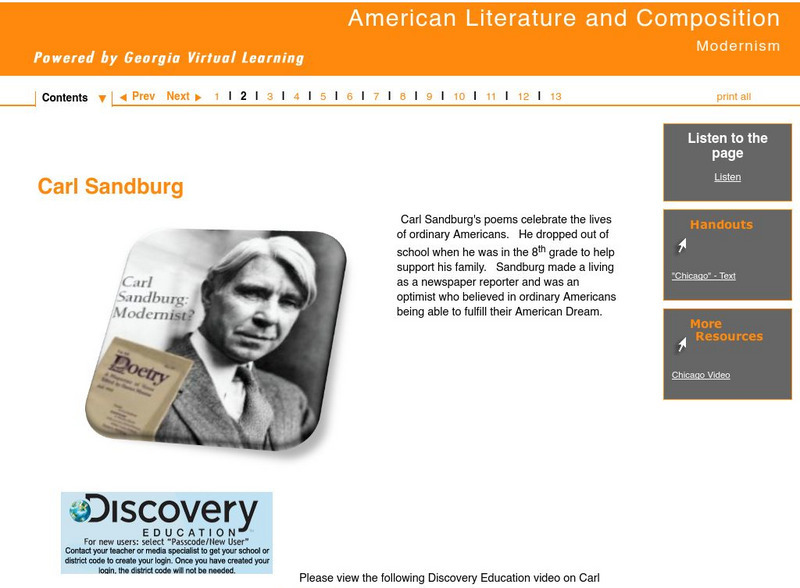Hi, what do you want to do?
Curated OER
Legends of the Fifth
Fifth graders discover the difference between myths, legends, and folk tales. They summarize legends. They work together to dramatize legends and then create their own legend using the writing process. Handouts and worksheets are included.
Curated OER
Titanic
Students conduct research with the purpose of writing a report about the Titanic. They use a variety of resources. The students produce a written document that has plenty of documented information. They also compare the information that...
Curated OER
From Ordinary To Extraordinary Writing
Students investigate the quality of writing while focusing on the use of sensory words to convey meaning and ideas. The power of similes and metaphors is emphasized while they create and edit works of writing. The skill of descriptive...
Curated OER
Fifth Grade Literature: January
Fifth graders examine and analyze various poems by Edward Hersey Richards, Robert Frost, and Emily Dickinson. They explore similes, and write journal entry responses.
Curated OER
Flora and Fauna as Figures of Speech
Students view artwork in manuscript pages depicting insects, animals, plants, flowers, and ornate writing, such as those found in the Mira calligraphiae monumenta in the Getty Museum.
Curated OER
Connecting Poetry with Philanthropy
Learners examine the different types of poetic conventions. They write a poem about philanthropy using these conventions. They illustrate their poem with artwork of their choice.
Curated OER
Solid Waste
Students examine how to use their vocabulary, writing skills, and creative thinking to address environmental concerns in this unit. They write messages to using creative writing to address the issues of solid waste and recycling.
ReadWriteThink
Read Write Think: Teaching Personification Through Poetry
This lesson plan examines the use of personification in the "great poets." Included in the lesson plan is an overview, practice, objectives, resources, preparation, and more.
Rock and Roll Hall of Fame
Rock & Roll Hall of Fame: Sti Lesson 7: Using Rock to Teach Literary Devices
Jimi Hendrix's 'The Wind Cries Mary' is an ideal song, not just to illustrate personification, but also to demonstrate how poetic devices enhance the meaning of the poem. As soon as the students recognize that the speaker is mourning the...
Read Works
Read Works: Grade 2: Three Lesson Unit: Figurative Language
[Free Registration/Login Required] A series of three lesson plans designed to teach students to identify and explain the meaning of figurative language including personification and idiom. Lessons are based on the books Once in a Blue...
Writing Fix
Writing Fix: The Poetry Lesson: Color Personification Poems
For this lesson, young scholars will choose a color and write a poem. Students will use personification and speak from the point of view of the color. Then young scholars will use watercolor paints to exemplify their poem about a color.
Scholastic
Scholastic: Poetry Unzipped: Personification in Poetry [Pdf]
Two page, PDF format handout about Richard Wilber's poem "The Death of a Toad" used as an example of personification. Also includes a student-written explanation of the poem and a few discussion questions.
Love To Know Media
Your Dictionary: Literary Terms Lesson Plan
This is a lesson plan for teaching the seven literary terms used in poetry: simile, metaphor, alliteration, imagery, hyperbole, personification, and onomatopoeia.
Vocabulary University
My vocabulary.com: Word Roots Lesson 6: Plic Fac Cogn:word Roots #6 Intermediate
This lesson plan features the Latin roots PLIC = fold, bend; FAC-FIC = make, do; COGN-NOT = know. Choose 1 of the 8 different word puzzle activities from the list below. Each word puzzle has directions, a clue and a vocabulary word list....
Read Works
Read Works: 2nd Grade Lesson: Personification
[Free Registration/Login Required] Students will use the book The Runaway Tortilla by Eric A. Kimmel to learn to identify and understand the use of personification in a fiction text. Lesson includes direct teaching, guided practice, and...
Read Works
Read Works: 2nd Grade Lesson: Figurative Language
[Free Registration/Login Required] A instructional activity in which learners use the book Once in a Blue Moon by Nicola Morgan to learn to identify and interpret the meaning of figurative language in a fiction text. Lesson includes...
Writing Fix
Writing Fix: Color Personification Poems
In this lesson, Hailstones and Halibut Bones, a book written by Mary O'Neill and Red Sings, and From Treetops: a Year in Colors, a book by Joyce Sidman, are used as mentor texts. Students will brainstorm to collect different adjectives,...
Georgia Department of Education
Ga Virtual Learning: Short Stories: "Young Goodman Brown" by Nathaniel Hawthorne
This lesson focuses on the short story "Young Goodman Brown" by Nathaniel Hawthorne. It features links to the article "The Salem Witchcraft Hysteria of 1692 and 'Young Goodman Brown'" and the PDF text for the short story. It also defines...
Texas Education Agency
Texas Gateway: Imagery and Figurative Language (Grade 8)
In this lesson, students learn how to make complex inferences and use textual evidence such as imagery and figurative language to support understanding.
Science Education Resource Center at Carleton College
Serc: Investigative Case: Protistan Tales of Atlantic White Cedar Swamps
A WebQuest where learners explore microbial diversity by looking at the extreme habitat of the Atlantic White Cedar Swamp. Students will learn about protists through personification theme of Aesop's Fables. At the end of the lesson,...
Georgia Department of Education
Ga Virtual Learning: American Transcendentalism: Key Terms
This lesson from a unit on American Transcendentalism focuses on key literary terms that fit the writings of the period and an interactive crossword puzzle using the terms and their definitions.
Georgia Department of Education
Ga Virtual Learning:american Literature and Composition: Modernism:carl Sandburg
This lesson focuses on Carl Sanburg and his poem "Chicago." It includes biographical information, as well as links to the poem, a video of pictures of Chicago in the early 20th century, and a "Discovery Education" video on Carl Sandburg....
Texas Education Agency
Texas Gateway: Imagery and Figurative Language (Grade 6)
This lesson focuses on the use of imagery and figurative language in writing to aid understanding and create images in the mind.
ReadWriteThink
Read Write Think: Figurative Language Awards Ceremony
Contains plans for five to seven lessons that teach about figurative language like similes, metaphors, and personification by asking learners to write award acceptance speeches that incorporate them. In addition to objectives and...
















![Scholastic: Poetry Unzipped: Personification in Poetry [Pdf] Unit Plan Scholastic: Poetry Unzipped: Personification in Poetry [Pdf] Unit Plan](https://content.lessonplanet.com/knovation/original/34502-bb3b353f9eb3e21dc4d528fca3f9487a.jpg?1661409330)











